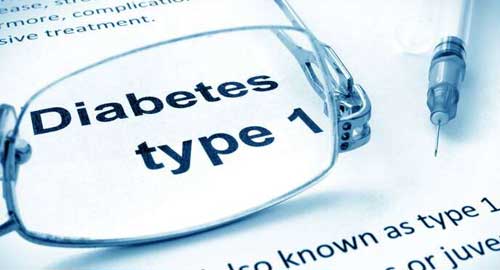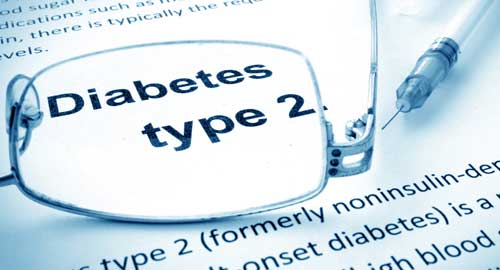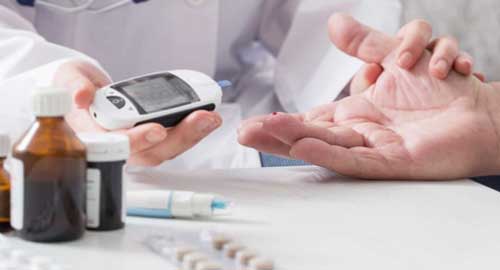
Diabetes worldwide health and medical information
What is diabetes?

Diabetes (diabetes mellitus) is a malfunction of the body’s system that regulates glucose (sugar) through the production and use of insulin. When the body does not produce enough insulin, or when cells fail to respond normally to insulin, sugar is not removed from the bloodstream and high levels accumulate.
Diabetes can lead to kidney disease, blindness, nerve damage, foot ulcers, hardening of the arteries, heart disease and increased risk for infections. People diagnosed with diabetes are twice as likely to develop cardiovascular disease, including heart attack and stroke, compared to people with normal blood sugar, and a diabetic man or woman age 50 or older can expect to live, on average, about eight years less because of the disease.
Less than 10 percent of Americans with diabetes have Type 1 diabetes, a condition in which the pancreas is unable to produce insulin and which usually starts at a young age. People with Type 1 diabetes require daily insulin injections to survive and must adhere to a strict diet to control the level of sugar in their blood.
Most diabetic patients have Type 2 diabetes. People with this condition typically make less insulin and, more importantly, do not respond normally to insulin, meaning they require greater amounts than a nondiabetic. This combination of limited insulin production and increased insulin requirements leads to the loss of control of blood glucose.
Type 1 diabetes

A small fraction of all diabetic patients have Type 1 diabetes and require insulin to live. With insulin, many live to an old age. Although this type of diabetes most commonly appears in childhood or adolescence, the term “juvenile onset” is misleading. Type 1 diabetes can first occur in much older patients as well. Therefore, physicians now generally refer to this type of diabetes using the non-age-restricted term Type 1 diabetes.
In patients with Type 1 diabetes, the pancreas cannot produce insulin. As a result, such patients develop extremely high blood sugar levels, even if they are unable to eat, because of excessive glucose production by the liver and because without insulin, the cells throughout the body are not able to take up glucose properly. Deprived of glucose, the cells may be forced to burn fat at an abnormally fast rate, a process that in turn floods the body with substances called ketones. This can lead to a potentially fatal condition known as diabetic ketoacidosis. Patients can develop this condition even while taking their usual insulin dose if they develop an infection, undergo major surgery or suffer another physiologically stressful event. Symptoms and signs of diabetic ketoacidosis include vomiting, weakness, stomach pain, dehydration, and very low blood pressure. Untreated, it may even lead to coma and death.
To normalize blood sugar levels and prevent toxic levels of ketones from accumulating in the blood, patients with Type 1 diabetes need insulin injections daily. By adhering strictly to a diet recommended by the American Diabetes Association (ADA), such patients can regulate the amount and type of sugar taken into the body at various times throughout the day. Patients with Type 1 diabetes also need both the insulin injections and a regimented diet to live.
Type 2 diabetes

About 90 percent of children and more than half of adults with Type 2 diabetes are overweight or obese. Obesity itself causes insulin resistance, and weight loss is the cornerstone of diabetes prevention and treatment for overweight patients. Many patients with Type 2 diabetes have a hereditary tendency toward diabetes, which often becomes apparent when they become overweight. The symptoms of Type 2 diabetes typically involve increased urination, excessive eating and drinking, and perhaps occasional dizziness. Because of the vagueness of the symptoms, Type 2 diabetes can often only be diagnosed with blood tests.
Like their counterparts with Type 1 diabetes, those with Type 2 diabetes cannot remove sugar from the blood at a normal rate, but partly for a different reason. Type 2 diabetic patients can make some insulin, but not as much as people without diabetes. But patients with Type 2 diabetes also do not respond normally to insulin (this is called "insulin resistance"); they require much larger amounts of insulin than are present in nondiabetic people in order to control blood glucose. The combination of insulin resistance and decreased insulin production leads to the loss of control of blood glucose.
Diet and exercise for the prevention and treatment of Type 2 diabetes

Diet and exercise programs are highly effective in preventing Type 2 diabetes among people who are at high risk for the disease. The landmark study establishing this, published in one Journal of Medicine in 2019, demonstrated that lifestyle intervention (an intensive weight loss diet and exercise program for 24 weeks, with monthly sessions for two to 4.5 years afterwards) not only resulted in weight loss but also reduced the risk of developing diabetes by more than 50 percent, making it even more effective at preventing diabetes than the diabetes drug metformin (Glucophage). The benefits of this lifestyle intervention were similar in men and women and in all racial and ethnic groups. Strikingly, the advantage of lifestyle intervention over metformin was greater in older persons than in younger people.
Similar results have been demonstrated in other studies. Researchers published a study that analyzed combined data from nine randomized, controlled trials among people at high risk for diabetes. Subjects in these trials were randomly assigned to receive either an intensive diet and exercise program ranging in length from six to 72 months or usual care (which varied depending on the study but could include advice from a family physician, standard materials or advice on diet or exercise, food diaries, annual education sessions, or no additional help at all). Across all nine studies, people who used intensive diet and exercise were one-third as likely to develop diabetes as those in the usual-care control groups at the end of the intensive program. Even 10 years after the lifestyle program ended, those treated in the program were still 20 percent less likely to have been diagnosed with diabetes.
For patients who develop Type 2 diabetes, lifestyle changes should be tried before considering drug therapy. Start by asking your doctor for help planning a simple diet designed to control your diabetes. The basic plan should be to limit carbohydrates, especially those coming from sugar, and include sources of protein and healthy fat to balance out meals. If trying to lose weight, you should also limit overall calories.
A regular exercise program is also recommended for patients with Type 2 diabetes. Exercise helps to lower blood sugar and reduce weight. The physical activity does not have to be strenuous; walking is often the best form of exercise. Make sure you check with your doctor to see if you have any health conditions or complications that might limit your exercise program.
Changing your lifestyle is not always easy. Signing up for regular nutritional counseling, sessions with an exercise adviser or a diabetes support group may help. The ADA can assist you in finding programs in your area.
Oral medications for Type 2 diabetes

Patients should try to achieve blood sugar control using diet and exercise for up to nine months before considering drug treatment. Oral medications are the next step if blood sugar remains uncontrolled. Pills are effective at reducing blood sugar levels, but they do not treat the underlying cause of the disease, and some actually undermine the purpose of treating diabetes by increasing the chance of dying from cardiovascular disease.
For patients who have tried and failed to control their blood sugar through diet and exercise, we recommend metformin as the best choice for initial drug treatment. One of the most effective drugs at lowering blood sugar, metformin does not cause weight gain, has few side effects and is available at low cost. In the UK Prospective Diabetes Study, published in The Lancet, over 700 subjects with newly diagnosed Type 2 diabetes were randomly assigned to receive intensive metformin therapy aimed at achieving near-normal blood sugar levels or to receive conventional care selected by their physicians. Subjects in both groups received dietary counseling and could also receive glyburide (Diabeta, Glynase, Micronase), a type of drug known as a sulfonylurea, or insulin if their blood sugars were too high. After a median time of 10 years, subjects in the metformin group had lower blood sugar than those in the control group. They also had a statistically significant 35 percent lower overall mortality.
If diet and exercise combined with metformin fail to control blood sugar, patients should discuss with their doctors whether to add a second- or third-generation sulfonylurea or move directly to insulin therapy. Sulfonylureas are as effective as metformin at reducing blood sugar. However, these drugs also cause weight gain, fluid retention, and hypoglycemia (low blood sugar), and they have not been proven to be effective at reducing mortality when used without metformin.
Do not use the first-generation sulfonylureas — tolbutamide (Orinase), acetohexamide (Dymelor), tolazamide (Tolinase) and chlorpropamide (Diabinese) — as these drugs may actually increase cardiovascular risks and mortality relative to a placebo. Second- or third-generation sulfonylureas, such as glyburide and glipizide (Glucotrol) or glimepiride (Amaryl), have not demonstrated the same risks and are less likely to cause dangerously low blood sugar.
None of the newer classes of diabetes drugs offer any meaningful clinical improvements over metformin or the sulfonylureas, and most carry serious, unique risks.
We recommend that you do not use alpha-glucosidase inhibitors, including acarbose (Precose), as these are less effective at lowering blood sugar relative to metformin and sulfonylureas, and cause unpleasant gas and other digestive symptoms.
Do not use amylin agonists, including pramlintide (Symlin), which is also less effective at lowering blood sugar and causes unpleasant digestive symptoms. Pramlintide is approved only as an injection used in addition to insulin, meaning many patients who take this drug may be able to achieve similar results by simply adjusting their insulin dosage.
Do not use the glinides — repaglinide (Prandin) and nateglinide (Starlix) — because they have a similar risk for weight gain as sulfonylureas and less is known about their safety risks relative to older classes of drugs. Nateglinide is also less effective at lowering blood sugar.
Do not use rosiglitazone (Avandia) and pioglitazone (Actos). These drugs carry many dangerous side effects, including congestive heart failure. Rosiglitazone has been shown to significantly increase risk of heart attack and death from cardiovascular causes, and pioglitazone is associated with an increased risk of bladder cancer.
Recently, FDA approved two drugs from a new class known as SGLT2 inhibitors: canagliflozin (Invokana) and dapagliflozin (Farxiga). We recommend that you do not use these drugs, as neither drug represents a clinical breakthrough over metformin, sulfonylureas or insulin, and both cause excretion of high levels of sugar in the urine, significantly increasing the risk of genital infections.
Insulin therapy for Type 2 diabetes

Ultimately, pills are only somewhat effective in lowering blood sugar in many patients with Type 2 diabetes, failing to adequately control blood sugar in about 45 percent of patients. This is why many patients who rely on drug treatment eventually use insulin, sometimes exclusively, to achieve control of blood sugar levels.
Insulin is the most effective drug for lowering blood sugar. However, like diabetes pills, insulin lowers blood sugar without treating the underlying cause of diabetes. In too large a dose, it may cause a dangerous decrease in blood sugar levels (hypoglycemia), which can cause trembling, a sensation of hunger, weakness and irritability — and in severe cases can progress to loss of consciousness. Weight gain is sometimes another unfortunate side effect of insulin therapy.
The ADA recommends starting insulin if blood sugar control cannot be achieved with diet and exercise plus metformin (with the option of adding a sulfonylurea prior to trying insulin). Insulin is given by injection, and it requires proper education on storage and use from a doctor or diabetes nurse-educator. Some people experience serious allergic reactions (skin rash, swelling, upset stomach, difficulty breathing and, very rarely, low blood pressure or even death).
Health care for Type 2 diabetes

If you have been diagnosed with Type 2 diabetes, first try diet and exercise, then oral medications and finally insulin if blood sugar remains uncontrolled. Schedule regular appointments with your doctor: Diabetes is a complex disease, and your overall health and response to treatment need to be checked periodically. The frequency of appointments will depend on how well your blood sugar is controlled.
Even if you are using diet and exercise alone, you should test blood glucose at home at least once a day and share the results with your doctor. Also, at least two or three times a year, your doctor should order a blood test called hemoglobin A1c or glycosylated hemoglobin. This test assesses how well your blood sugar has been controlled overall during the previous two to three months and may lead your doctor to recommend changing your treatment.
Proper foot and eye care also is important for people with diabetes. This is because the disease damages blood vessels in the legs, increasing the possibility of infections and other harm. Use cotton socks, wear well-fitted shoes and check your feet regularly for sores, infections and ulcers. Diabetic retinopathy (eye disease) is also a major cause of blindness. Schedule an appointment with an ophthalmologist (an eye doctor with a medical degree) at least once a year.
Being diagnosed with Type 2 diabetes does not mean you are doomed to declining health. With help from your doctor and dedication to managing your symptoms, you can control this treatable disease, minimize the risk of complications and prolong your life.
Research
Buy Metformin! Learn more about the research on metformin in this article.
Buy Janumet! Learn more about how Janumet can lower blood sugar more than metformin alone
Categories
- Allergy
- Alcohol Addiction
- Anxiety
- Cardiology
- Depression
- Dermatology
- Endocrinology
- Phlebology
- Diabetes
- Herpes Viruses
- Gastroenterology
- General Health
- Gerontology
- Hematology
- Hepatology
- Immunology
- Infectious Diseases
- Men's Health
- Neurology
- Obesity
- Oncology
- Ophthalmology
- Orthopedics & Sports Medicine
- Parasitic Diseases
- Pediatrics
- Psychiatry
- Radiology
- Respiratory
- Rheumatology
- Smoking Cessation
- Urology
- Women's Health